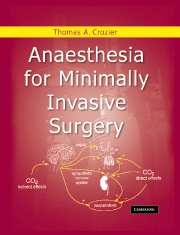Book contents
- Frontmatter
- Contents
- Preface
- Foreword
- Acknowledgements
- 1 Introduction
- 2 Physiology
- 3 Preparing and positioning for laparoscopic surgery
- 4 Monitoring
- 5 Anaesthesia for laparoscopic surgery
- 6 Complications and contraindications of laparoscopic surgery
- 7 Post-laparoscopy pain and pain relief
- 8 Laparoscopic bariatric surgery
- 9 Minimally invasive thoracic surgery
- 10 Laser surgery of the upper aerodigestive tract
- 11 Minimally invasive neurosurgery
- Index
2 - Physiology
Published online by Cambridge University Press: 21 October 2009
- Frontmatter
- Contents
- Preface
- Foreword
- Acknowledgements
- 1 Introduction
- 2 Physiology
- 3 Preparing and positioning for laparoscopic surgery
- 4 Monitoring
- 5 Anaesthesia for laparoscopic surgery
- 6 Complications and contraindications of laparoscopic surgery
- 7 Post-laparoscopy pain and pain relief
- 8 Laparoscopic bariatric surgery
- 9 Minimally invasive thoracic surgery
- 10 Laser surgery of the upper aerodigestive tract
- 11 Minimally invasive neurosurgery
- Index
Summary
The physiological consequences of laparoscopic–endoscopic surgery are primarily due to the effects of increased intra-abdominal pressure (IAP) and the systemic absorption of the insufflated gas. The magnitude of these changes is modulated by the position of the patient and the choice of insufflation gas.
Operations in the peritoneum, uterus or bladder require active expansion of the pre-existing cavity by the application of exogenous pressure. This is usually unnecessary for thoracoscopy, where the self-retracting tendency of the lungs is exploited and reinflation of the lungs is prevented by a selective ventilation, such as with a double-lumen endotracheal tube. In operations on organs surrounded by connective tissue, such as in the retroperitoneum (nephrectomy, adrenalectomy, lymphadenectomy), the groin (hernia repair), or in the mediastinum, an artificial cavity must be created with insufflated gas or with the aid of a dilation balloon. The specific effects of these measures will occur in addition to the already ongoing changes resulting from anaesthesia and surgery.
Circulation
During laparoscopic surgery, the circulation undergoes typical changes of cardiac output (CO), blood pressure, venous pressure and cardiac filling pressures that are the result of the complex interactions between anaesthesia, patient position, pressure changes in the body cavities and neuroendocrine reactions. Depending on the circumstances, the effects of these factors can either reinforce each other or they can cancel each other out.
Increased IAP and the patient's position (supine, head-down Trendelenburg, or head-up reverse Trendelenburg) are – given constant arterial carbon dioxide (CO2) tension – the main determinants governing circulatory changes during laparoscopy.
- Type
- Chapter
- Information
- Anaesthesia for Minimally Invasive Surgery , pp. 7 - 34Publisher: Cambridge University PressPrint publication year: 2004



